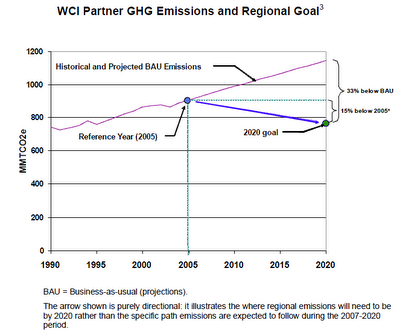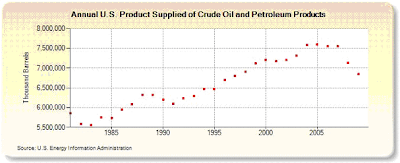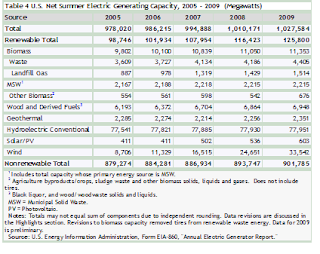Summary: Our planet is struggling to limit the growth in atmospheric greenhouse gases arising from burning of fossil fuels over the last 150 years. The increased amounts of greenhouse gases are thought to be responsible for global warming.
In this post we characterize the use of energy in the United States, most of which is generated from the burning of fossil fuels that produce greenhouse gases. A companion analysis for China was presented in the preceding post.
Projections of future energy demand and its production, both in the U. S. and worldwide, predict increased annual emissions of greenhouse gases, leading to rising accumulation of these gases in the atmosphere. This predicted growth, in conjunction with other recent studies of greenhouse gas emissions, leads to a conclusion that limiting production of greenhouse gases is of the utmost and immediate importance.
Introduction. The United States, as the developed country with the largest population and the most vigorous economy of the world, has consumed a large fraction of the world’s energy for the last few decades. In this post a breakdown of recent and current consumption patterns for the major sources of energy in the U. S. is presented. Then a projection of future trends for the next 25 years is provided.
Essentially all the information below was obtained from the U. S. Energy Information Agency (USEIA), an office within the Department of Energy.
Petroleum. U. S. domestic production of crude oil peaked in 1970. In 2009 the U. S. imported approximately 4,250 million barrels of oil, and produced just under 2,000 million barrels, or about 32% of the total used. The graphic below shows the total consumption of crude oil (“product supplied”) from 1980 to 2009, in thousands of millions (billions) of barrels of oil.
Source: USEIA. http://www.eia.gov/dnav/pet/hist/LeafHandler.ashx?n=pet&s=mttupus1&f=a
The trends for total oil consumed, as for other fossil fuels, decreased during 2008-9 due to economic adversity and lower weather-related demand Late in 2010, the USEIA projected that for all of 2010 total consumption of crude oil and liquid fuels increased to about 6,968,000 thousand barrels, representing an increase of about 1.7% over 2009.
Natural Gas. Total consumption of natural gas since 1949 is shown in the graphic below. After a period of dramatic growth ending about 1972, consumption fell over the following decade, and has increased to levels that stayed approximately constant since 2000.
Source: USEIA. http://www.eia.gov/dnav/ng/hist/n9140us2A.htm
Data for 1999-2009 is expanded in the graphic below, with additional projections of usage (blue line, left hand scale), and yearly percent changes (red bars, right hand scale), for 2010 and 2011.
Source: USEIA. http://www.eia.gov/emeu/steo/pub/gifs/Fig17.gif
Over the years improvements in home construction and the efficiency of major appliances have resulted in significant drops in residential consumption of natural gas. After accounting for variations in weather, residential consumption on a per customer basis over the 19-year period from 1990 to 2009 fell by 22 percent.
The decrease in total gas consumption for 2009, and the subsequent increase for 2010, are attributed to the effects of the weakened economy and its rebound in those two years, as well as to weather conditions that weakened demand. For example, the U. S. Federal Reserve Board has determined that capacity utilization in the nation’s factories was 70.4% in 2009, down from 77.5% in 2008.
According to the USEIA, use of natural gas in the generation of electricity has grown widely in the past two decades, at the expense of coal. In 2009, natural gas made up almost 24 percent of net power generation in the U. S, whereas in 1996, natural gas made up only 14 percent. In contrast, over this interval use of coal for power generation fell from 50 percent in 1995 to 45 percent in 2009.
U.S. Coal Production and Usage. The graphic below shows the long term production (red line) and consumption (broken green line) of coal in the U. S. since 1949. The difference between these lines is reflected in net exports (black line). It is seen that over the period shown coal use has more than doubled.
The decline in coal consumption during 2009 was the consequence of the domestic economic conditions combined with the weather during the year, which resulted in lower demand for electricity (see below). Consumption of coal for the first 6 months of 2010 increased slightly. Consumption of coal in 2010 was predicted to grow by 1 percent (see the following graphic). USEIA projects that coal production in 2011 will remain relatively flat.
Source: USEIA. http://www.eia.doe.gov/cneaf/coal/quarterly/html/t32p01p1.html
The electric power sector, which consumes about 94 percent of U. S. coal, is the overriding factor determining total domestic coal consumption. In 2009, the recession’s downward pressure on electricity production resulted in a large decrease in coal consumption for the sector. Electricity. Explanation of Units. The watt is a unit of power, i.e., the rate of producing or using energy in a standard period of time. When watts are multiplied by the time elapsed, we get the total amount of energy produced or consumed; in electricity jargon this energy unit is a watt-hour, or W-h. More convenient amounts of power generation are measured in thousands of watts, or kilowatts (kW), and billions of watts, or gigawatts (GW). The total amount of energy produced or used over a period of time, is expressed in thousands of W-h, or kilowatt-hours,(kW-h, on a household scale), or in millions or billions of kW-h (on an industrial scale or higher).
U.S. Electricity Consumption. The national overall consumption of electrical energy recorded between 1999 and 2009, and predicted for 2010 and 2011, is shown by the upper blue line in the graphic below, in billions of kW-h per day. (In order to compare this with a similar graphic in the previous post on China, which shows electrical energy for entire years, the “9”, “10” and “11” on the left-hand y-axis below would be “3,285”, 3,650” and “4,015”, respectively.)
As seen for the forecast years to the right of the vertical line, the USEIA expects U.S. electricity consumption will rise by 4.7 % in 2010 (see the above graphic, the lower red bars with the scale along the right-hand y-axis). For 2011, U.S. consumption of electricity is predicted to grow by only 0.2%, as increased usage in the industrial sector is offset by decreased predicted use in residential energy.
By far the largest consumer of coal in the U. S. is the electrical generation industry. USEIA forecast that coal consumption by this sector would grow by 5.7 percent in 2010, but would decline by 0.2 percent in 2011.
In contrast, it was foreseen that generation from non-fossil-fuel-fired sources would increase, and that natural gas-fired generation would also decline. Increases in the proportion of electricity provided by nuclear energy and hydroelectric power are offset by a comparable decrease in coal-fired generation.
Renewable Energy. The sources for all forms of energy consumed in the U. S. during the years 2004-2008 are shown in the table below. The numbers are in units of quadrillion British Thermal Units (Btu’s), where 1 quadrillion = 1 million billion, or “1” followed by 15 zeroes. In the table, purely by chance, the totals for all years across the top row are accidentally very close to 100, so that all the entries below the top line can be usefully interpreted as percents.
Before discussing the renewables, it should be noted from the table that total energy usage in the U. S. remains remarkably constant in the five years shown. Likewise, the major components of this energy consumption, total fossil fuels, nuclear electric power and conventional hydroelectric power, remain essentially unchanged in this period.
Changing trends are seen only for renewable energy, which increases from about 6.2% in 2004 to about 7.4% in 2008. Most of this increase in consumption occurs in biomass (this includes biofuels such as ethanol), and wind energy, which increases dramatically from about 0.1% in 2004 to about 0.5% in 2008. Even so, while these increasing trends are significant, they still make very small contributions to the overall sourcing of the U. S. national energy mix. It is also significant that solar, which includes both focused thermal and photovoltaic electricity installations, constitutes a miniscule portion of the overall energy sourcing, even though it grew from about 0.07% in 2004 to about 0.1% in 2008.
The fractional breakdown of sourcing in 2008 is presented in the pie chart below. Please note that the percents shown on the right for renewable energy are the percents of the 7% renewable sector, totaling 7.367 quadrillion Btu.
The table below emphasizes renewable generating capacity in the U. S. between 2005 and 2009 (second line). The table shows that virtually all the increase in renewables arises from additional wind generation capacity (next–to-last line), which grew from 9,000 MW to 33,500 MW.
Source: USEIA. http://www.eia.doe.gov/cneaf/solar.renewables/page/table4.html
CO2 and Greenhouse Gas Emissions: Past, Present and Future. Carbon dioxide (CO2) is the most important greenhouse gas because of the overwhelmingly large amount produced by the burning of fossil fuels. In terms of the useful amount of heat energy obtained per carbon atom upon burning, coal is the weakest, liquid fuels such as gasoline and diesel are higher, and natural gas (mainly methane) is much higher.
The heat-trapping ability of CO2 on a molecule-for-molecule basis, however, is relatively weak; its overwhelming importance is due to the massive amounts emitted by burning the large amounts of fossil fuels used in the world economy. Methane or natural gas, when not burned as a fuel, escapes into the atmosphere from many sources; molecule-for-molecule methane is about 25 more potent in heat-trapping effectiveness than CO2. Another gas arising from human activity, nitrous oxide (N2O), is even stronger, about 300 times more potent than CO2; other industrial gases, including sulfur hexafluoride (SF6) and a set of hydrofluorocarbons and perfluorocarbons, range as high as 23,000 times more potent than carbon dioxide molecule-for-molecule. Thus small amounts of these gases in the atmosphere have effects that are many multiples of those of CO2. Numerical conversions are made when reporting data for those gases into a unit called a CO2-equivalent.
Atmospheric emissions of all greenhouse gases, reported as CO2-equivalents, are shown in the table below for 1990, 1995 and the years from 2000 to 2008. As noted in earlier sections, 2008 represents the depth of the economic recession in the U. S.; burning of fossil fuels continued to increase in 2009 and 2010.
Source: USEIA. http://www.eia.doe.gov/oiaf/1605/ggrpt/index.html. High-GWP Gases refers to high global warming potential gases given by footnote a.
A proportional pie chart of the data for 2008 is shown below.
USEIA expects fossil-fuel CO2 emissions to increase by 3.9 percent in 2010, and to remain more or less unchanged during 2011. These fossil-fuel-based emissions are predicted to remain below levels experienced during the period 1999 through 2008.
The end-use distribution of emissions for only CO2, excluding other greenhouse gases, is shown in the following pie chart.
Source: USEIA. http://www.eia.doe.gov/oiaf/1605/ggrpt/index.html#total .
An important measure for the global warming effects of greenhouse gas emissions is the carbon intensity. This is a measure of how much CO2 and equivalents are emitted into the atmosphere for each unit of economic activity as measured by a nation’s gross domestic product (GDP). The following table gives the carbon intensity for the U. S. for the years 1990, 1995 and 2000-2008. It is seen that
U.S. Greenhouse Gas Intensity and Related Factors, 1990 to 2008 |
|
Year | 1990 | 1995 | 2000 | 2001 | 2002 |
|
Greenhouse Gas Intensity (MTCO2e per Million 2005 Dollars) | 770.2 | 717.2 | 624.4 | 607.0 | 601.9 |
|
|
|
|
|
|
|
|
Year | 2003 | 2004 | 2005 | 2006 | 2007 | 2008 |
Greenhouse Gas Intensity (MTCO2e per Million 2005 Dollars) | 592.5 | 583.2 | 568.3 | 547.2 | 544.0 | 529.8 |
the carbon intensity decreases significantly over this period. This reflects not only increased productivity in turning out goods per unit of economic activity, but also greater efficiencies in residential energy use and a shift in the economy away from energy-intensive activities and toward less intense service industries.
The USEIA posted its Early Release Overview http://www.eia.gov/forecasts/aeo/ of the Annual Energy Outlook 2011 for the U. S. in December 2010. It includes the following prediction of total U. S. CO2 emissions up to 2035. Such predictions are sensitive to assumed effects of current policies and private sector decisions including those based on anticipated price trends
on consumption of fossil fuels leading to CO2 emissions. These assumptions form the basis of the Reference case in this prediction (see title of graphic).
The historical and projected distribution of fuel types that provide energy for the U. S. is shown in the following graphic, between 1980 and 2035. Overall energy use characterized as Btu’s consumed (converting electrical energy to the Btu
Source: USEIA AEO2011 Early Release Overview http://www.eia.gov/forecasts/aeo/
equivalent) increases over the forecast period. Of the classes shown, renewables, liquid biofuels and nuclear energy do not produce significant net CO2 emissions. The remaining classes correlate with the low rate of increase of predicted CO2 emissions shown in the preceding graphic, above. It is encouraging, from the point of view of predicted greenhouse gas emissions, that essentially all the projected growth occurs in the fuel classes that do not emit CO2, namely, renewables and liquid biofuels.
Worldwide energy use and greenhouse gas production. Over the past decades, the countries of the developed world have had relatively stable rates of low increases in energy use and emission of greenhouse gases, as their economies are already mature and their rate of growth of population is low. In contrast, the developing countries of the world have been growing rapidly, as more of their populations become urbanized or otherwise energy-dependent; in addition the populations in many of these countries have grown rapidly. This economic growth has been fueled by correspondingly increasing rates of fossil fuel-derived energy and emission of greenhouse gases. These trends are illustrated in the following graphic, showing the U. S. and China, and
Sources: USEIA including its AEO2009.
http://www.eia.doe.gov/oiaf/1605/ggrpt/index.html#total
the Organization for Economic Cooperation and Development (OECD) and non-OECD countries of the world. The OECD is an organization of 34 countries with advanced or relatively mature economies. These include the U. S., most European countries, and Japan, Korea, Australia and New Zealand in Asia. China and most Latin American countries are not part of OECD. Importantly, the non-OECD group also includes rapidly growing countries such as India and Brazil.
The graphic above shows that while the U. S. (pale green) and OECD generally (dark blue-green) have produced and are predicted to produce modestly increasing amounts of CO2, China (light purple) and the rest of the non-OECD countries (brown) have been, and will continue, emitting multiplied amounts of CO2 over the years. The USEIA International Energy Annual 2006 reports http://www.eia.doe.gov/oiaf/1605/ggrpt/index.html#total that OECD as a whole, is predicted to have a 0.2% average annualized rate of growth of CO2 emissions between 2006 and 2030, which is responsible for 7.2% of the increase in actual tonnage of CO2 emissions. The corresponding numbers for non-OECD nations of the world are 2.2% average annualized rate of growth of CO2 emissions, which is responsible for 92.8% of the actual increase in tonnage of CO2 emissions. (Follow the link for more detailed data and analysis.)
Atmospheric Greenhouse Gases Continue to Increase in Coming Decades. The graphic above and the data just cited present the stark prospect envisioned for at least the next two decades that in each year worldwide emissions of greenhouse gases get larger and larger. This means that, since most emitted greenhouse gases are not removed from the atmosphere, they keep on accumulating year after year, building up a stronger greenhouse effect with each passing year. In an earlier post, the atmosphere was likened in a simplified way to a bathtub containing an atmosphere with CO2. As the faucet adds more CO2, the CO2 level in the bathtub keeps rising since the drain is shut.
In other posts, the World Energy Outlook (WEO) 2010 published by the International Energy Agency, and an article by Davis and coworkers with a commentary by Hoffert have stressed the very dire situation that we will actually face in the future. Recent predictions of future global warming from the United Kingdom and the United Nations suggest that average global temperatures could rise 4 deg C (7 deg F) or more from today by the end of the century. These and other reports emphasize the immediate need to undertake major, drastic efforts to cut back on global greenhouse gas emissions, and to install renewable and sustainable energy sources as soon as possible.
















